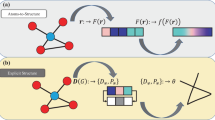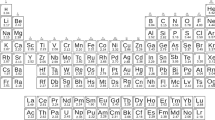Abstract
Nanostructures may be fabricated from metal nanoclusters such as gold or platinum, which are of interest for catalytic and structural characteristics, or from nano forms of carbon allotropes. Here, informational thermodynamic properties such as free energy, enthalpy, and entropy are calculated using a graph network model at T = 298.15 K. We calculate the partition function using Euclidean adjacency matrices from the Hamiltonian and estimated bond energies. The summed atomic displacement from the Kirchhoff index has power law behavior, while the thermodynamic properties exhibit large \(N\) logarithmic behavior: however, the data shows structurally related anomalies.





Similar content being viewed by others
References
J. Gong, Chem. Rev. 112, 2987–3054 (2012)
W. Zhou, J. Wu, H. Yang, Nano. Lett. 13, 2870–2874 (2013)
B.K. Teo, N.J.A. Sloane, Inorg. Chem. 24, 4545–4558 (1985)
J.M. Montejano-Carrizales, F. Aguilera-Granja, J.L. Moran-Lopez, NanoStructured Mater. 8(3), 269–287 (1997)
F. Kim, S. Connor, H. Song, T. Kuykendall, P. Yang, Angew. Chem. 116, 3673–3677 (2004)
K. Koga, T. Ikeshoji, K. Sugawara, Phys. Rev. Lett. 92(11), 15507 (2004)
S.W. Lu, V. Frain, M. Arbab, J. Phys. Chem. C 114, 12850–12854 (2010)
K. Koga, K. Sugawara, Surf. Sci. 529, 23–35 (2003)
Y. Li et al., J. Am. Chem. Soc. 134, 17997–18003 (2012)
A. Sanchez-Iglesias, I. Pastoriza-Santos, J. Perez-Juste, B. Rodriguez-Gonzalez, F. Javier, F.J. Garcia de Abajo, L.M. Liz-Marzan, Adv. Mater. 18, 2529–2534 (2006)
W. Zhu, A.-X. Yin, Y.-W. Zhang, C.-H. Yan, Chem. Eur. J. 18, 12222–12226 (2012)
K.M. Bratlie, H. Lee, K. Komvopoulos, P. Yang, G.A. Somorjai, Nano Lett. 7(10), 3097–3101 (2007)
C.M. Sanchez-Sanchez, J. Solla-Gullon, F.J. Vidal-Iglesias, A. Aldaz, V. Montiel, E. Herrero, J. Am. Chem. Soc. 132, 5622–5624 (2010)
Y.H. Chui, G. Grochola, I.K. Snook, S.P. Russo, Phys. Rev. B 75, 033404 (2007)
H. Akbarzadeh, G.A. Parsafar, Fluid Phase Equilib. 280, 16–21 (2009)
J.L. Delgado, M.A. Herranz, N. Martin, J. Mater. Chem. 18, 1417–1426 (2008)
H.W. Kroto, J.R. Heath, S.C. O’Brien, R.F. Curl, R.E. Smalley, Nature 318, 162–163 (1985)
S. Iijima, Nature 354, 56–58 (1991)
K.S. Novoselov, A.K. Geim, S.V. Morozov, D. Jiang, Y. Zhang, S.V. Dubonos, I.V. Grigorieva, A.A. Firsov, Science 306, 666–669 (2004)
W. Gordy, J. Chem. Phys. 15(5), 305–310 (1947)
J.P. Paolini, J. Comput. Chem. 11(10), 1160–1163 (1990)
L. Pauling, J. Phys. Chem. 58(8), 662–666 (1954)
R.C. Powles, N.A. Marks, D.W.M. Lau, Phys. Rev. B 79, 075430 (2009)
Y. Yamaguchi, L. Colombo, P. Piseri, L. Ravagnan, P. Milani, Phys. Rev. B 76, 134119 (2007)
P.J.F. Harris, Carbon 45, 229–239 (2007)
B.V. Lebedev, K.B. Zhogova, T.A. Bykova, B.S. Kaverin, V.L. Karnatsevich, M.A. Lopatin, Russ. Chem. Bull. 45(9), 2113–2117 (1996)
V.B. Muratov, O.O. Vasil’ev, L.M. Kulikov, V.V. Garbuz, Yu.V. Nesterenko, T.I. Duda, J. Superhard Mater. 34(3), 173–178 (2012)
E. Estrada, N. Hatano, Chem. Phys. Lett. 439, 247–251 (2007)
M. Backman, N. Juslin, K. Nordlund, Eur. Phys. J. B 85, 317–322 (2012)
K. Albe, K. Nordlund, R.S. Averback, Phys. Rev. B 65, 195124 (2002)
J.E. Hearn, R.L. Johnston, J. Chem Phys. 107, 4674–4687 (1997)
M. Alcami, G. Sanchez, S. Diaz-Tendero, Y. Wang, F. Martin, J. Nanosci. Nantechnol. 7, 1329–1338 (2007)
W.H. Qi, M.P. Wang, J. Nanoparticle Res. 7, 51–57 (2005)
J.T. Miller, A.J. Kropf, Y. Zha, J.R. Regalbuto, L. Delannoy, C. Louis, E. Bus, J.A. von Bokhoven, J. Catal. 240, 222–234 (2006)
M. Klimenkov, S. Nepijko, H. Kuhlenbeck, M. Baumer, R. Schlogl, H.-J. Freund, Surf. Sci. 391, 27–36 (1997)
S.E. Massen, C.P. Panos, Phys. Lett. A 26, 530–533 (1998)
E. Estrada, N. Hatano, Chem. Phys. Lett. 486, 166–170 (2010)
I. Gutman, B. Mohar, J. Chem. Inf. Comput. Sci. 36, 982–985 (1996)
J.R. Lombardi, B. Davis, Chem. Rev. 102, 2431–2460 (2002)
K. Kern, R. David, R.L. Palmer, G. Comsa, T.S. Rahman, Phys. Rev. B 33(6), 4334–4337 (1986)
S.Y. Davydov, Phys. Solid State 52, 1947–1951 (2010)
W.I.F. David, R.M. Ibberson, J.C. Mathewman, K. Prassides, T.J.S. Dennis, J.P. Hare, H.W. Kroto, R. Taylor, D.R.W. Walton, Nature 353, 147–149 (1991)
S.R. Gadre, Phys. Rev. A 30(1), 620–621 (1984)
W. Kratschmer, L.D. Lamb, K. Fostiropoulos, D.R. Huffman, Nature 347, 354–358 (1990)
F.H. Kaatz, M.P. Siegal, D.L. Overmyer, P.P. Provencio, D.R. Tallant, Appl. Phys. Lett. 89, 241915 (2006)
A.S. Barnard, N.P. Young, A.I. Kirkland, M.A. van Huls, H. Xu, ACS Nano 3(6), 1431–1436 (2009)
A.S. Barnard, H. Konishi, H.F. Xu, Catal. Sci. Technol. 1, 1440–1448 (2011)
F.H. Kaatz, A. Bultheel, J. Math. Chem. 51, 1211–1220 (2013)
F.H. Kaatz, A. Bultheel, J. Math. Chem. 51, 1221–1230 (2013)
F.H. Kaatz, E. Estrada, A. Bultheel, N. Sharrock, Phys. A 391, 2957–2963 (2012)
Acknowledgments
F. H. Kaatz thanks A. Fasolino for sharing atomic coordinates of rippled graphene, and thanks E. Estrada for programming assistance.
Author information
Authors and Affiliations
Corresponding author
Appendix
Appendix
We recently published some results describing power law behavior with the thermodynamic properties [48–50]. We now show that these power law relationships are equivalent to the logarithmic properties shown in this manuscript.
Suppose the thermodynamic property is \(P\) and we consider
where \(N_{B}\) is the number of bonds and \(A\), \(B\), and \(c\) are constants with \(N_{B}\) = cN. We then have
and thus
If we use this expression in Eq. (14), we have
Now both terms on the right go to zero as \(N\) \(\rightarrow \) \(\infty \), but the first one is faster than the second one. Hence for large N, the dominant term is BN \(_{B}^{-1}\) ln (\(N_{B})\). Because ln (\(N_{B})\) \(<\) (\(N_{B})^{\alpha }\) for \(N\) \(\rightarrow \) \(\infty \) and \(\alpha \) \(>\) 0, we shall have the result we are intending to prove
and the original expression for \(P\) (Eq. 14) shows the logarithmic behavior.
Rights and permissions
About this article
Cite this article
Kaatz, F.H., Bultheel, A. Informational thermodynamic model for nanostructures. J Math Chem 52, 1563–1575 (2014). https://doi.org/10.1007/s10910-014-0336-y
Received:
Accepted:
Published:
Issue Date:
DOI: https://doi.org/10.1007/s10910-014-0336-y




